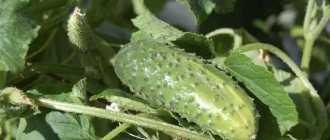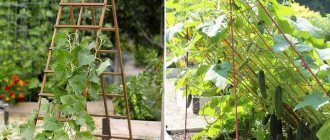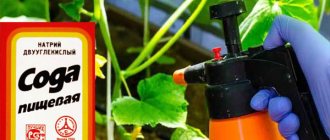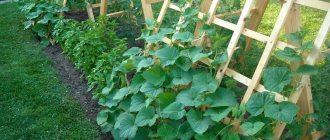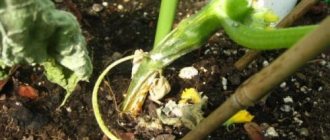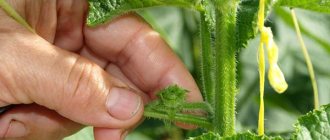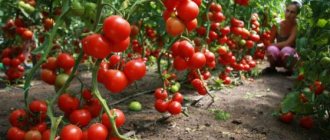Mulching cucumbers allows gardeners not only to increase the yield, but also to provide good protection against drying out of the soil and the active germination of weeds. The beneficial effect on the soil also includes soil enrichment. For mulching, you can use two types of coatings:
- Natural. This includes hay, sawdust, chopped grass, and so on. The disadvantage of this option is the need to regularly update the coating. But an additional bonus will be the constant fertilization of the soil.
- Artificial. For this purpose, spunbond or polyethylene is used. You can also use gravel or pebbles.
Pros and cons of mulching cucumbers
One of the main dangers for cucumbers is sudden changes in temperature, which can destroy the crop. Mulching helps to cope with this problem. In addition, the protective coating maintains a normal level of soil moisture and prevents it from drying out. Another advantage is that the number of weedings is reduced. Weeds do not germinate well in closed soil. So, what are the benefits of mulching?
- Provides a good level of soil moisture.
- Reduces the number of weeds.
- Covered soil does not overheat in hot weather and does not freeze during frosts.
- During irrigation, water is distributed evenly over the soil, there is no waterlogging.
- Pathogens do not transfer from the surface of the earth to shoots.
- The soil structure becomes much better, the soil is not subject to erosion.
- Mulching protects the soil from the formation of a hard crust, which prevents water and fertilizers from being absorbed.
- The coating creates a favorable environment for the emergence and development of beneficial microorganisms.
- The root system of cucumbers begins to develop more actively.
Even if you mulch just once, the crop will ripen about two weeks earlier. The shoots do not have to be hilled. Cucumbers receive significantly more nutrients, and the fruits are better protected from adverse factors. Even their taste improves.
But there are also disadvantages. Thus, not only beneficial microorganisms can develop, but also pathogens. There is also a high probability of fungus appearing. Another problem is nitrogen deficiency, which can cause mulching.
The best mulch
Mulch useful for the garden should perform the following functions:
- retain moisture;
- stabilize the soil and prevent its erosion;
- inhibit the growth of weeds (serving as an alternative to chemical herbicides);
- increase biological activity in the soil (being a breeding ground for microorganisms);
- enrich the soil with minerals (due to slow decomposition);
- improve the soil structure over time (if used correctly);
- Ideally, it should have an attractive appearance and not violate the integrity of the landscape design of your site.
What makes a good mulch? In fact, there are enough options to suit every taste and budget.
Conifer bark
Pine and larch bark is ideal for use as mulch. This is a natural, environmentally friendly material that decomposes well, promotes soil drainage, making it more moisture- and breathable. In addition, it has a noble dark color that does not lose saturation under the influence of rain and sun. It is easy to find on sale, and it costs quite reasonable money. Suitable for mulching tree trunks and shrubs, as well as beds and flower beds.
Soil improver
The mixture to improve soil quality may include peat, sapropel, crushed conifer bark, etc. It can be used not only “internally” – when preparing the soil for planting, but also “externally” – as mulch. The soil improver is good for mulching beds and flower beds.
Straw
Some gardeners do not use straw as mulch, fearing that it will begin to rot. Yes, it does retain moisture, but it only begins to rot in the greenhouse. The soil, covered with a straw cover, becomes loose, “breathes” well, and does not require frequent watering even in dry summers. You can forget about hoes and cultivators!
Straw can be used to cover berry and vegetable beds. During heavy rains, the straw layer will protect the fruits from contact with the ground, and therefore from rotting. But it’s better not to overdo it with shrubs: if you lay the straw in too dense a layer, this will slow down the growth of young shoots.
Straw that has served as mulch is perfect for composting.
Conifer needles
It’s hard to think of a more “natural” type of mulch than fallen pine needles. If pine or spruce trees grow on your site, consider yourself very lucky!
However, there is one important nuance: green pine needles cannot be used to mulch young, actively growing plants. “Fresh” needles contain terpene, which inhibits the development of sprouts. But brown needles no longer contain this chemical, so they are absolutely safe. Green needles can be used for mulching crops that love acidic soil, but only during the flowering and fruiting period.
Green needles will protect plants from invasion of slugs and snails.
fallen leaves
How much effort we put into the fall to clear the garden of fallen leaves... But in vain! Foliage is an excellent winter “coat” for perennials. In addition, leaf cover protects the soil from drying out and erosion and promotes the breeding of earthworms.
Next time you find yourself in the forest, try lifting a layer of fallen leaves - the ground underneath is alive in the full sense of the word.
Gravel
Of course, small pebbles do not increase the biological activity of the soil, but they are indispensable in rainy areas, as they protect the soil from washing out. Plus, gravel mulch will last you for years! A very profitable investment.
Ground cover plants
What about living mulch? This is not only good for the soil, but also beautiful! To save time, effort and money, choose perennial ground cover plants: ivy, creeping thyme (popularly known as thyme), etc.
Sphagnum moss
Sphagnum perfectly neutralizes alkaline soils. It is capable of absorbing large volumes of moisture, so your plants are not afraid of any drought in the “sphagnum” blanket! Another valuable quality of sphagnum is its antiseptic properties.
Keep in mind that this mulch is not suitable for every crop. Strawberries and wild strawberries, for example, will begin to rot under such cover, but blueberries or raspberries will feel great. Roses, azaleas, peppers, radishes, pine and spruce trees will respond well to sphagnum.
How to mulch cucumbers in a greenhouse and open ground: step-by-step instructions
In order for mulching to be beneficial and for the shoots not to be damaged, it is important to adhere to certain rules. There are three ways to distribute mulch. They are suitable for cucumbers in greenhouses and open ground:
- Solid. The bed with seedlings is completely covered with mulch in an even layer.
- In rows. The mulch is distributed on separate rows, the row spacing remains free.
- Nests. A small area around each shoot is covered with a layer of mulch. This option prevents the appearance of weeds well, but does not ensure the maintenance of a normal level of soil moisture.
Read the article on how to make a greenhouse and greenhouse for cucumbers, incl. made of polycarbonate with your own hands.
What steps should you take to properly mulch?
- Soil preparation. Remove old mulch if there is any. Weed out the weeds. Leave the area to dry and warm up.
- Loosening. The top layer is dug to a shallow depth. Only 10-12 cm will be enough.
- Coverage distribution. The mulch is laid evenly, the layer thickness should be no more than 5 cm. A small area around the stem should remain free.
- Now you can start working with the plantings. The mulch must be watered immediately to begin the composting process. From time to time it is necessary to look under the covering in order to notice the appearance of diseases or pests in time.
After the season is over, the mulch becomes humus. All residues are destroyed, as they may contain viruses and pathogens.
Important! If cucumbers grow in open ground, the layer of mulch must be renewed more often, as it will compost faster.
Optimal time
It is necessary to mulch the surface of the tomato beds only when the weather is warm and the soil is well warmed up. As a rule, this occurs in late May - early June, depending on the region.
- Laying mulch early insulates plant roots from incoming heat, “preserving” cold in the soil.
- Delaying the covering of the ground will lead to the opposite effect: the soil will have time to overheat under the influence of the scorching sun, and the covering material will not allow the soil to give off excess heat.
Rushing or delaying mulching the soil will harm the full development of the plant. The optimal time for the procedure is the period when the soil warms up to a depth of 20 - 30 cm to +15 *ºС.
Laying mulch on the surface of tomato beds allows you to get a good harvest and save the gardener’s time. This process requires painstakingness, a reasonable approach and adherence to a number of recommendations. The soil should be mulched at the appropriate time, strictly adhering to the correct sequence of operations. It is also important to consider the nature of the material that is used for mulching. In open ground, it is better to use organic mulch.
Mr. Summer Resident warns: mistakes when mulching
Improper mulching will not only not give the desired effect, but can cause harm to plants. Therefore, our portal https://mrdachnik.com reminds you that you need to pay attention to all factors - soil type, weather. Here are a few of the most common errors:
- The shoot touches the mulch. This is the cause of diseases. There must be a small free space near the stem (tops).
- Organic mulch should not be fresh, otherwise it will serve as a bait for pests.
- Inorganic types of coating should not be used in regions with hot climates, as they will cause severe overheating.
- The soil must warm up well before laying mulch.
- If sawdust or shavings are used, spreading them over the ground in rainy weather is unacceptable. They will swell and block the access of oxygen to the root system.
The soil must first be loosened and weeded. The organic coating must be renewed periodically. If symptoms of the disease are detected, the mulch layer is immediately removed.
What is the best way to mulch tomatoes in beds?
Materials used for mulching can be divided into two categories: organic and inorganic mulch. Before choosing any particular type, you should consider the basic recommendations regarding what you can use to mulch tomatoes:
- The material must be accessible; its high cost in this case will not be justified.
- The decomposition products formed as a result of the decomposition of the lower layer of mulch should enrich the soil and not harm it and plants.
- Artificial material retains heat well at the roots of the plant, while organic matter is an additional fertilizer. Taking into account the level of soil fertility and climatic conditions, you should choose the type of mulch that will be most relevant.
What is left after standard agricultural practices is usually used as organic materials for mulching tomatoes:
- hay, straw, mown grass or dry stems of cultivated plants;
- humus;
- sawdust;
- crushed tree bark;
- compost;
- peat;
- moss;
- dry leaves.
The following is used as an artificial covering material:
- spunbond;
- lutrasil;
- black and red film.
Spunbond and lutrasil are types of high-quality non-woven coverings that are highly breathable, so that mold will not form under such a cover. The main difference: price and manufacturer.
Lutrasil is a German agrotextile, spunbond is its Russian analogue, respectively, the price of the former is an order of magnitude higher. You can read more about the best materials for mulching tomatoes in open ground in a separate article.
Organic mulch is laid out on the ground after planting seedlings, and inorganic materials - before planting begins.
We recommend watching a video on how to properly mulch tomatoes in open ground:
Dangerous mulch
If the types of mulch from the previous group can be used in your garden in exceptional cases, then the following mulch should be completely abandoned:
- mulch is crowded around the trunk of a tree or shrub (this dehydrates the plant);
- not composted mulch (fresh, not rotted mulch, especially in large quantities, can literally burn the garden: during the process of rotting, the temperature of the compost rises);
- toxic mulch (it is unnecessary to talk about the dangers of toxic materials);
- garbage (recycling of waste is commendable, but its products are not suitable for mulching the garden).
Dyed mulch
Mulch in acid shades looks bright and catchy, but certainly not aesthetically pleasing. And she is very far from naturalness! Natural materials are always healthier and look much nicer.
Plastic or glass mulch
Such mulch retards the growth of young plants, reduces the biological activity of the soil, sticks together under the influence of the environment and looks very cheap.
Hay mulch
Unlike straw, hay should not be used for mulching beds and flower beds. Hay is a carrier of weed seeds. It is not necessary to describe in detail what will happen to your garden thanks to such mulch. In addition, the hay quickly begins to rot under the influence of moisture.
When choosing the type of mulch for your site, it is important to remember that you should use it with caution, carefully choosing the “coat” material for the beds and flower gardens. When the choice is between healthy plants and a garden that doesn't need weeding, always choose the former. In this case, your beds will thank you with an enviable harvest.
